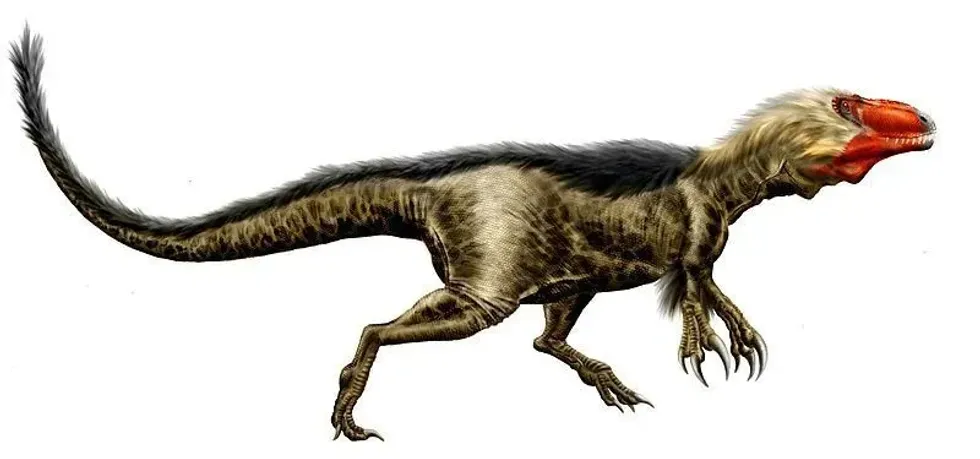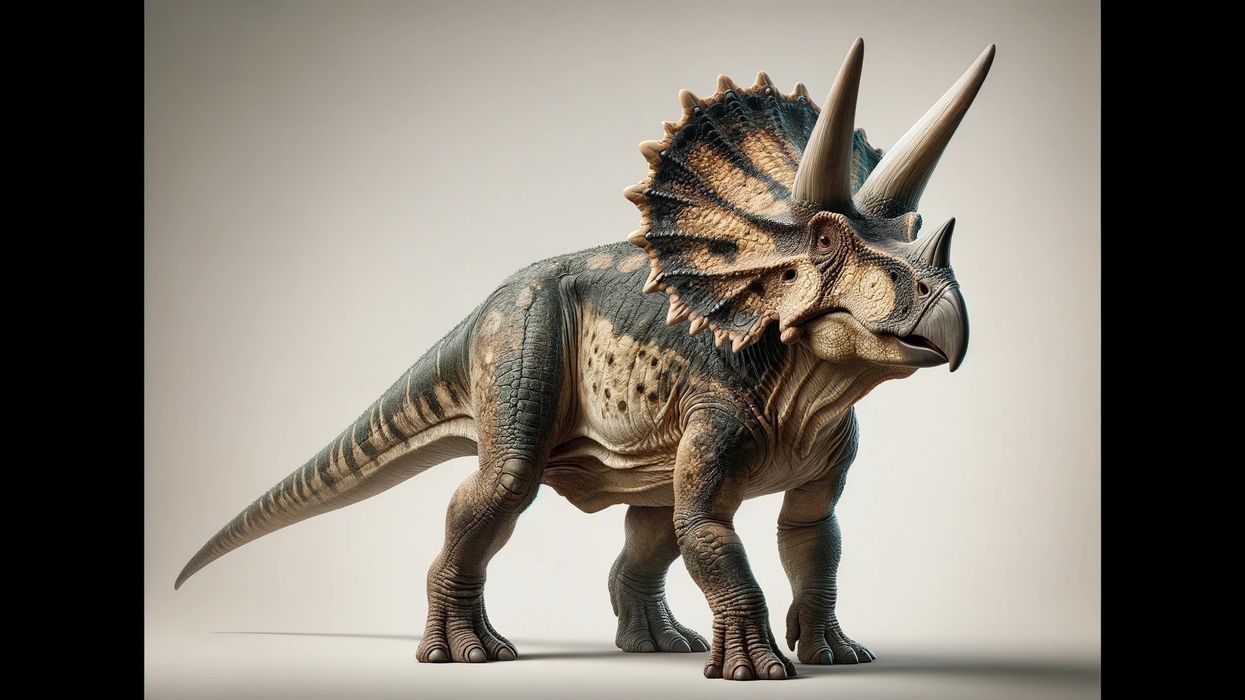The Dryptosaurus, whose name is derived from Greek mythology and translates as 'tearing lizard', was a formidable hunter of the Late Cretaceous Period (100.5-66 million years ago).
The sharp-clawed predator is noted for its distinctly large, hook-like claws and proportionally longer arms, suggesting a specialized hunting strategy that set it apart from other predators of its time.
Fossil records of the enigmatic theropod are scarce, with much of the classification within theropod lineages still under scientific debate.
Nevertheless, this dinosaur has carved out a significant niche in the study of North America's Cretaceous Period fauna, emerging as an iconic representation of prehistoric life along the East Coast.
Remnants discovered within the geologic layers of the New Egypt Formation provide a window into an era dominated by vast island landmasses. It is here that the hook-clawed hunter, among other theropod dinosaurs, thrived.
These fragmented fossils, all that is left of the mysterious carnivore's existence, are critical in piecing together the ancient landscapes that once supported such diverse life forms.
Although the full picture of the long-armed dinosaur's life remains incomplete, the fossilized evidence at humans' disposal unlocks portions of their story, hinting at a creature exceptionally adapted to its environment.
With each bone fragment and tooth unearthed, paleontologists edge closer to understanding the role the formidable predator played within its ancient ecosystem, a testament to the complexity and marvel of the natural history.
Dryptosaurus Interesting Facts

How do you pronounce 'Dryptosaurus'?
The name Dryptosaurus is pronounced 'DRIP-toh-saw-rus'.
What type of dinosaur was it?
Dryptosaurus was a theropod dinosaur, known for being a bipedal carnivores, and was believed to be the only large carnivore present in its ecosystem.
In which geological period did this dinosaur roam the Earth?
The Dryptosaurus roamed the Earth during the Late Cretaceous Period, approximately 67 million years ago.
When did the Dryptosaurus become extinct?
Dryptosaurus became extinct at the end of the Cretaceous Period, likely due to the mass extinction event that affected all non-avian dinosaurs.
Where did this dinosaur live?
The Dryptosaurus lived in what is now the eastern part of North America, primarily within the New Egypt and Navesink Formations.
What was their habitat?
The habitat of Dryptosaurus was likely dense, forested areas and floodplains, providing ample cover and hunting grounds for this predator.
Who did they live with?
It is largely unknown who the Dryptosaurus might have lived with, as their social structure and group dynamics remain uncertain due to limited fossil evidence.
How long did this dinosaur live?
The lifespan of a Dryptosaurus is not known, as data from their fossils does not provide enough information to make a precise estimate.
How did they reproduce?

Like all known dinosaurs, Dryptosaurus would have reproduced by laying eggs, but details about their mating rituals and reproduction are unknown due to a lack of fossil evidence.
Dryptosaurus Fun Facts
What did they look like?
Dryptosaurus was characterized by its bipedal stance and relatively long arms compared to other theropods, as well as having sharp, recurved claws, suggesting it was a predator.
How many bones did a Dryptosaurus have?

The exact count of bones in Dryptosaurus is unknown due to incomplete fossil records; however, theropods typically had numerous bones, including a multitude of vertebrae, ribs, and a complex arrangement of limb bones.
How did they communicate?
The communication methods of Dryptosaurus are not understood, but they may have used visual displays, vocalizations, and body language similar to modern birds and reptiles.
How big was the Dryptosaurus?
An adult Dryptosaurus could grow up to an estimated 25 ft (7.5 m) long and about 7.2 ft (2.2 m) at the hip.
How fast could this dinosaur move?
There is no specific information on the speed of Dryptosaurus, but as a theropod, it could likely move quickly to hunt prey.
How much did a Dryptosaurus weigh?
The Dryptosaurus weighed approximately 3,307 lb (1,500 kg) based on the size of known skeletal elements.
What were the male and female names of the species?
There are no specific terms for male and female Dryptosaurus as there are for some animal species.
What would you call a baby Dryptosaurus?
A baby Dryptosaurus would be referred to as a hatchling or juvenile.
How aggressive were they?
Though direct evidence of behavior is sparse, as the region's apex predator, Dryptosaurus was likely quite aggressive when hunting or defending territory.
Did You Know…

The theropod's damaged partial tooth crowns and unusual features like long arms seem to suggest a creature adapted for a distinct ecological niche.
Yet, much about this prehistoric predator remains shrouded in mystery, leaving many facets of its existence up to scholarly interpretation and future discovery in dinosaur paleontology.
As one of the Cretaceous East Coast dinosaurs, the enigmatic carnivore adds to the picture of a dynamically populated region.
The Cretaceous Period on the East Coast of what is now North America was home to numerous theropod species, each with adaptations that allowed them to thrive in diverse environments and ecological niches.
The dinosaur Dryptosaurus was initially described in 1866, marking it as one of the earliest theropod fossils to be scientifically recognized in North America. Its discovery offered early insights into the variety of predatory dinosaurs that once roamed the planet.
The fearsome hunter was closely related to other theropods in morphology, displaying similar traits, but with distinct features characterizing its subgroup within the broader theropod classification.
The fossil material assigned to the ancient predator was limited, primarily consisting of damaged and incomplete bones, yet they were significant enough to warrant a new genus, providing crucial information about its size, potential behavior, and place in the food chain.
Discovered partial remains, although scant, have helped paleontologists paint a rough picture of what this formidable carnivore may have looked like and how it lived, highlighting the fragmented but fascinating journey of piecing together prehistoric life.
Dryptosaurus aquilunguis was designated as the type species of the genus Dryptosaurus, setting a reference point for classification and further studies of related theropod discoveries. It remains an important species for understanding the evolutionary history of dinosaurs in North America.
The classification of the elusive theropod within the various theropod families has been a subject of debate due to its incomplete fossil record.
While some connections to other dinosaur groups remained uncertain, the anatomical features it shares with other known theropods suggest the enigmatic hunter had a place within the vast and diverse evolutionary tree of theropods.
The notable Navesink Formation is the geological formation within New Jersey where the partial remains of the mysterious predator were first discovered. This geologic layer has provided valuable insights into the types of environments and species that existed in the Late Cretaceous of the region.
Knowledge of Dryptosaurus and other theropods discovered comes primarily from fragmented and fossilized bones that endure in the rocky deposits from the time they once lived. Each discovery offers a chance to learn more about the diversity of theropod dinosaurs.
Understanding the various theropod families helps scientists piece together the evolutionary lineage of dinosaurs like the elusive carnivore. These families are categorized based on distinct physical characteristics, behaviors, and ecological roles that have been deduced from the fossil record.
While the fearsome predator is primarily associated with the East Coast, references to the Lance Formation, located in the Western United States, emphasize the widespread distribution of theropods across ancient North America.
The Lance Formation is another significant fossil site known for its abundance of Late Cretaceous dinosaur remains, including various other theropod species.
The classification of the enigmatic theropod within theropod families has changed over time. Originally grouped with megalosaurids by Cope, it was reassigned to its own family, Dryptosauridae, by Marsh.
Later phylogenetic studies in the '90s proposed Dryptosaurus as a coelurosaur, reflecting an evolving understanding of its relationships within the theropods. However, its exact placement within this diverse group remained uncertain.
Various theropod species have been attributed to the mysterious carnivore, although they were identified from quite incomplete fossils and likely represent different types of theropods.
Species once assigned to Dryptosaurus but now considered possibly incorrect include Dryptosaurus macropus, Dryptosaurus falculus, and Dryptosaurus hazenianus.
FAQs
Was this dinosaur a Tyrannosaurus?
It was not a Tyrannosaurus, although they share similarities as they are both members of the group known as theropods. This dinosaur predates the Tyrannosaurus, having roamed the Earth during the Late Cretaceous Period, while the Tyrannosaurus lived later, toward the end of the Cretaceous.
While Dryptosaurus and Tyrannosaurus are both categorized under Theropoda, they belong to different families. Dryptosaurus is part of the Dryptosauridae family, a distinction that separates it from the more famously known Tyrannosaurus which is placed under the Tyrannosauridae family.
Distinguishing characteristics of Dryptosaurus include its smaller size and different morphological features compared to the Tyrannosaurus. It had relatively long arms with large, sharp claws, which were unusual among theropods and not typically seen in members of the Tyrannosauridae family.
Ultimately, Dryptosaurus is not a Tyrannosaurus. While they may be distantly related and share some characteristics as predators of the same broader classification, they are distinctly different species with separate evolutionary histories.
Was this dinosaur as big as T-Rex?
No, it was not as large as the Tyrannosaurus rex. Dryptosaurus estimates suggest it measured up to 25 ft (7.5 m) in length and weighed around 3,307 lb (1,500 kg), making it smaller than the T-Rex, which could reach lengths of up to 40 ft (12.2 m) and weigh as much as 19,841 lb (9000 kg).
What distinguishes this dinosaur from other dinosaurs?
It is distinguished by its relatively long arms adorned with large, sharp claws, suggesting a predatory adaptability. Unlike many theropods that had shorter arms, Dryptosaurus' limbs indicate it might have used them for seizing prey. This physical trait sets it apart in the theropod lineage.
Where were the first fossils of this dinosaur discovered?
The first fossils of this creature were discovered in the New Egypt Formation of New Jersey, which is part of Eastern North America. The initial find consisted of partial and fragmented fossils providing limited but valuable insights into the dinosaur's characteristics.
Did it have feathers?
While there is no direct fossil evidence of feathers on this dinosaur, it is a possibility given its classification as a theropod. Some close relatives of the dinosaur are believed to have had feathers, so it is not unreasonable to speculate that this dinosaur might have had them too.
What did this dinosaur eat?
Being a carnivore, this dinosaur fed on other animals. Its teeth and claws suggest that it hunted small to medium-sized prey, potentially smaller dinosaurs. The specifics of its diet are still a subject of research as more fossils are analyzed.
How did scientists determine the age of this creature's fossils?
The age of this dinosaur's fossils is determined through a combination of relative dating and radiometric dating techniques.
By studying the stratification of rock layers and using isotopic dating methods on volcanic layers, paleontologists have concluded that the dinosaur lived approximately 67 million years ago during the Late Cretaceous Period.
The dinosaur brings to life the rich tapestry of this planet's ancient past. Unraveling the secrets of these Cretaceous dinosaurs not only sheds light on the complex ecosystems that once flourished but also fuels the imaginations of kids and adults alike.
Though much of its life remains largely unknown, the creature's limited remnants provide invaluable insight into the diversity of life that thrived on the island continent that was eastern North America, over 67 million years ago.
Related Articles Around the Web













